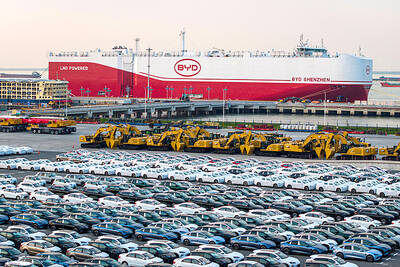Taiwan High Speed Rail Corp (THSRC, 台灣高鐵) managed to narrow its losses to NT$2.7 billion (US$82.3 million) in the first half thanks to lower overhead costs, the company said yesterday.
The debt-ridden company, which has been hit by a slump in demand amid the economic downturn, trimmed its net loss by 75 percent to NT$2.7 billion compared with NT$11 billion for the same period last year.
THSRC spokesman Ted Chia (賈先德) attributed the improvement to a recovery in the number of passengers, lower interest rates and changes to the company’s accounting rules.
Despite the downturn, passenger ticket revenue totaled NT$11.5 billion in the first half, up from NT$10.8 billion last year, after the company introduced a series of discounts that cover 81.2 percent of its trains, the data showed.
The central bank’s relaxed monetary policy helped lower the company’s borrowing costs, with interest dropping to NT$5.5 billion in the first half from NT$8.1 billion last year, Chia said.
The spokesman said the company is seeking to cut its expenses further as its interest rates remain relatively high at between 2.6 percent and 2.8 percent. The rate stood at about 4 percent for part of the loan last year, from 8 percent a year earlier, Chia said.
In addition, Chia said THSRC abandoned the straight-line method in favor of a different formula for writing off depreciation costs, which fell to NT$4.07 billion in the first six months from NT$9.45 billion a year earlier.
Under the new method, depreciation costs pick up modestly in the short run but surge sharply in the long run, Chia said, adding that the company is seeking government approval for dividing the expenses over a longer period.
The summer saw mixed results, with the number of passengers rising to 2.95 million in July from 2.81 million last year, but dropping sizably last month, when the company suspended operations for two days because of Typhoon Morakot, Chai said.
“The storm must have dented revenues, although final figures are not available yet,” he said, adding that passengers averaged 90,000 a day.
Eric Lai (賴建承), an analyst at Marbo Securities Consultant Co (萬寶證券投顧), said THSRC expected to report further improvement in the second half as companies and individuals spend more on travel amid a recovery in the economy.
However, Lai said a dramatic improvement was unlikely based on the company’s financial records.
Despite its improved finances, THSRC has more than NT$70 billion in accumulated losses, representing 67 percent of the company’s capital.
Chai said the company’s refinancing plan had made no headway as banks kept calling for a capital injection — an idea that the company has dismissed as impractical.

Micron Memory Taiwan Co (台灣美光), a subsidiary of US memorychip maker Micron Technology Inc, has been granted a NT$4.7 billion (US$149.5 million) subsidy under the Ministry of Economic Affairs A+ Corporate Innovation and R&D Enhancement program, the ministry said yesterday. The US memorychip maker’s program aims to back the development of high-performance and high-bandwidth memory chips with a total budget of NT$11.75 billion, the ministry said. Aside from the government funding, Micron is to inject the remaining investment of NT$7.06 billion as the company applied to participate the government’s Global Innovation Partnership Program to deepen technology cooperation, a ministry official told the

Taiwan Semiconductor Manufacturing Co (TSMC, 台積電), the world’s leading advanced chipmaker, officially began volume production of its 2-nanometer chips in the fourth quarter of this year, according to a recent update on the company’s Web site. The low-key announcement confirms that TSMC, the go-to chipmaker for artificial intelligence (AI) hardware providers Nvidia Corp and iPhone maker Apple Inc, met its original roadmap for the next-generation technology. Production is currently centered at Fab 22 in Kaohsiung, utilizing the company’s first-generation nanosheet transistor technology. The new architecture achieves “full-node strides in performance and power consumption,” TSMC said. The company described the 2nm process as

Shares in Taiwan closed at a new high yesterday, the first trading day of the new year, as contract chipmaker Taiwan Semiconductor Manufacturing Co (TSMC, 台積電) continued to break records amid an artificial intelligence (AI) boom, dealers said. The TAIEX closed up 386.21 points, or 1.33 percent, at 29,349.81, with turnover totaling NT$648.844 billion (US$20.65 billion). “Judging from a stronger Taiwan dollar against the US dollar, I think foreign institutional investors returned from the holidays and brought funds into the local market,” Concord Securities Co (康和證券) analyst Kerry Huang (黃志祺) said. “Foreign investors just rebuilt their positions with TSMC as their top target,

POTENTIAL demand: Tesla’s chance of reclaiming its leadership in EVs seems uncertain, but breakthrough in full self-driving could help boost sales, an analyst said Chinese auto giant BYD Co (比亞迪) is poised to surpass Tesla Inc as the world’s biggest electric vehicle (EV) company in annual sales. The two groups are expected to soon publish their final figures for this year, and based on sales data so far this year, there is almost no chance the US company led by CEO Elon Musk would retain its leadership position. As of the end of last month, BYD, which also produces hybrid vehicles, had sold 2.07 million EVs. Tesla, for its part, had sold 1.22 million by the end of September. Tesla’s September figures included a one-time boost in